Share the post "48 Important Soccer Rules (A-Z Explained)"
With so many soccer rules, it is difficult to know where to start. So, I formed the most important soccer rules in an easy-to-follow A-Z list.
Soccer rules address fouls, restarts, scoring, and everything in between for soccer. The rules aim to ensure a safe, fair game for all parties.
These important soccer rules range from;
- Advantage play
- Kit rules
- Zonal marking
All of the rules are explained so that they’re easy to understand. Let’s take a look at the first important rule …
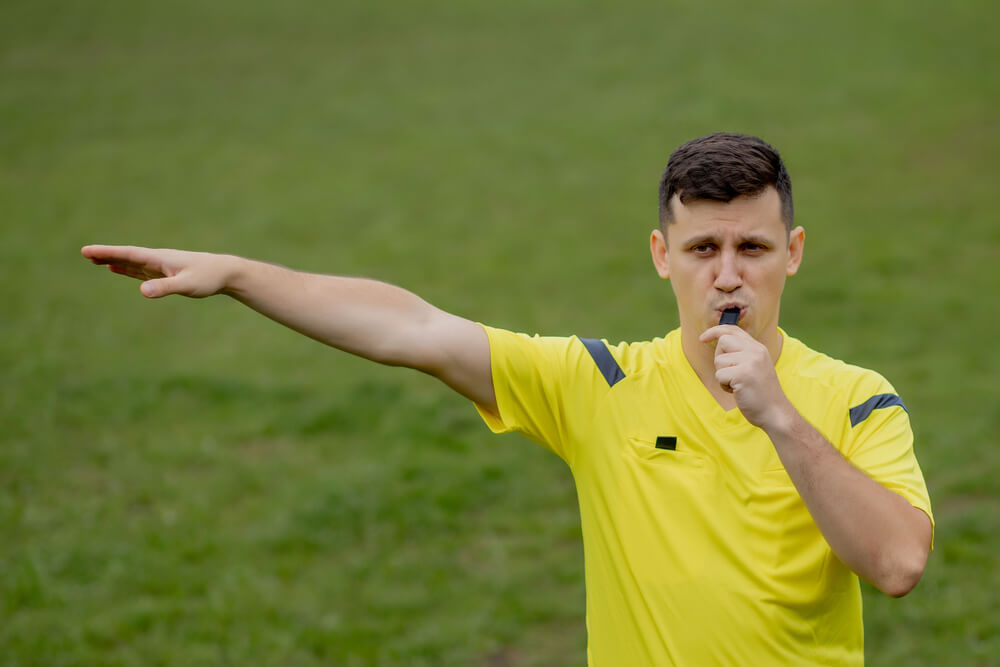
Important Soccer Rules
After reading this article, you will easily understand what is happening in a game. It makes the game confusing when the rules are unclear. So let’s clear up the important rules for you to enjoy soccer more.
Advantage Play
If the opposition commits a foul, the referee might decide to let play continue – they will call advantage and direct their arms forward.
The advantage rule allows play to continue and keeps the game flowing. But only if the attacking team fouled can take advantage of the situation.
If the player who is fouled loses the ball before playing the ball, the referee will go back to the first offense and award the first foul.
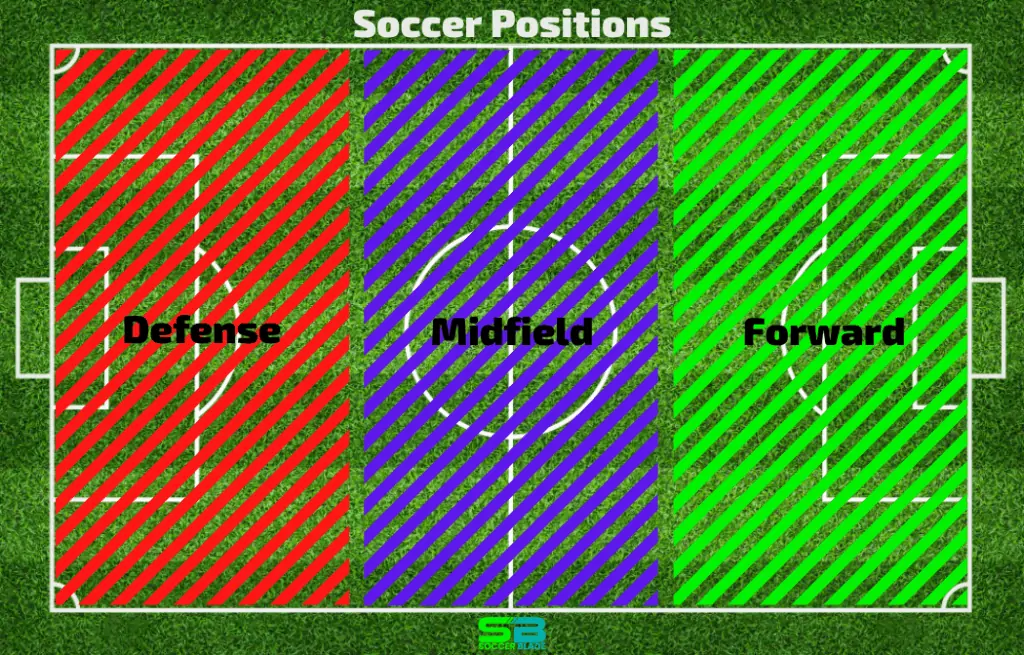
Back pass to goalkeeper
Players can pass the ball back to their goalkeeper. However, when a player intentionally plays the ball back to their goalkeeper, their goalkeeper cannot use their hands (even in the box).
If the goalkeeper handles an intentional back pass, the opponent receives an indirect free kick at the handling spot.
However, if the handling happened within the 6-yard box, then the indirect free kick is taken from the 6-yard line at the closest spot of the infraction.
- There are two caveats to this rule. For one, the pass must be the intention. If a player goes to clear the ball and it ricochets off their leg toward the goal, and the keeper saves it, this is not a back pass.
The other caveat (which we will dive into in another section) is if the back pass is completed with the player’s head.
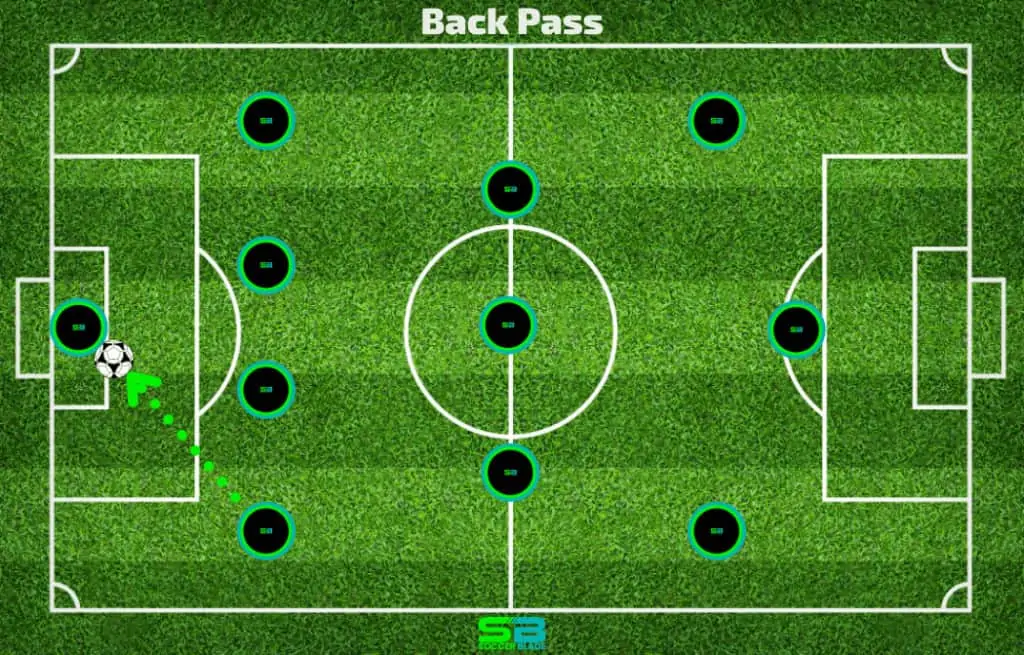
Body Checking
Soccer players cannot throw their hips or body into other players. Calling body checking can be very difficult unless it is blatantly obvious.
When a player throws their hips into an opponent on the dribble, it is very clear to see and call body checking.
However, when a player has a ball position and is shielding it, determining body checking is not always as clear.
Ball Out of Bounds
The ball can go out of bounds over the sideline or either end line. The ball is considered out of bounds only when the entire ball passes over the line.
When the ball goes out of bounds over the sideline, a throw-in is awarded to the team that did not make the ball go out of bounds.
- If Team A makes the ball go out of bounds (accidentally or intentionally with any body part), Team B receives a throw-in at the location the ball went out.
When the ball goes out of bounds over an end line, it will result in either a corner kick or goal kick, which we’ll detail shortly.
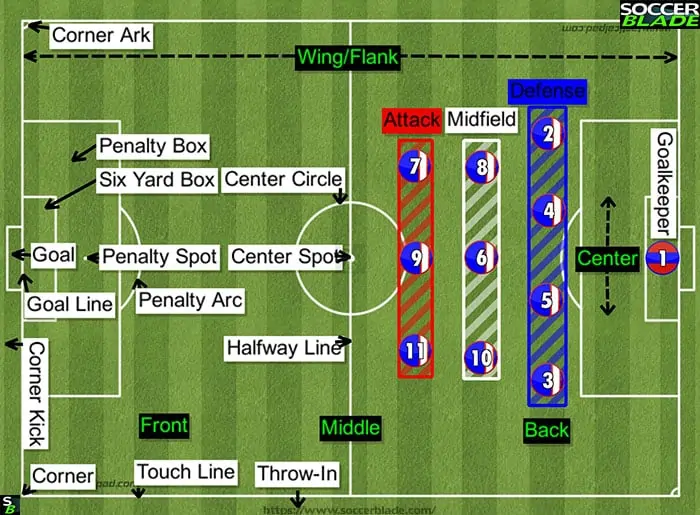
Ball Crossing the Goal Line
The goal line is the part of the end line that is contained within the frame of the goal. The ball must completely cross the goal line to be considered a goal. It is not a goal if the ball does not fully cross the goal line.
In most competitions, the referee must determine if the ball fully crossed the plane of the goal.
In high-level competitions, like the World Cup or Champions League, referees may consult VAR to review whether or not the ball crossed the goal line.
- It’s important to remember that it does not matter who puts the ball over the goal line.
If Team B is defending and their player accidentally kicks the ball over their defensive goal line, Team A is awarded a goal.
Ball Hits the Referee
If the ball hits the referee and changes possession or crosses the goal line, a drop ball is awarded to the team who had possession before the contact.
Cards
The referee uses cards to discipline players. Every foul does not result in a card, only certain offenses.
The referee will face the player to administer the card and raise it in the air. The referee then records the player’s jersey number and the card issued.
Yellow cards are used to caution players, and a red card removes a player from the game.
Two yellow cards equal a red card, so upon receiving a second yellow a player must exit the game.
Corner Kick
The attacking team receives a corner kick when the defending team hits the ball over their defensive end line.
If Team A is defending and they put the ball out of bounds over their defensive end line, then Team B received a corner kick.
A corner kick is taken at the corner of the field. The ball must be placed within the arch around the corner. It can be placed on the line of the arc.
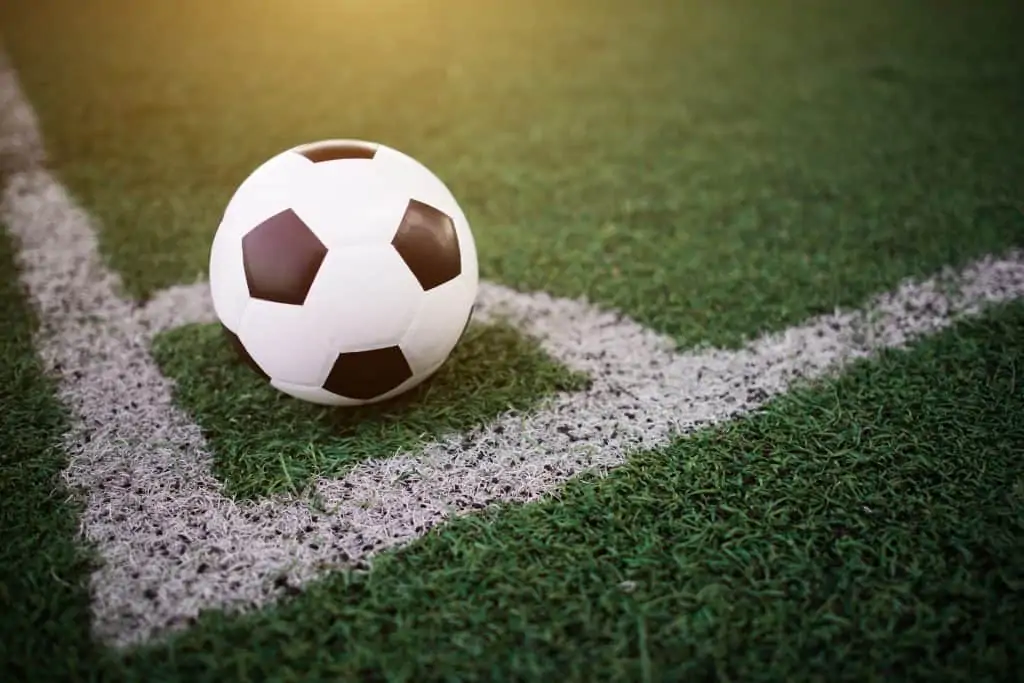
The corner kick player cannot touch the ball twice a row. A goal can be scored directly off of a corner kick. It does not have to touch another player.
Contact with the Goalie
Contact with the goalie is permitted in soccer. However, referees tend to be cautious with goalkeepers and very strict about the type of contact.
When goalkeepers enter a 50/50 situation, contact is a normal result.
For example, normal contact may occur if a goalkeeper goes up to punch or catch the ball at the same time an opposing player jumps up to head the ball.
Attacking players are likely to be called for a foul if contact with the goalie is:
- Late. occurring after the ball is secured or put out of the area of play.
- Studs up, sliding in with studs up at the goalkeeper.
- Near the head. If a goalkeeper comes to get the ball and a player swings near their head, the referee will likely make a call.
- Reckless.
Calling Mine
Calling out “mine” is a common way to communicate with teammates.
- However, if a defending player calls out “mine” to deceive an attacking player, they may be punished for unsporting behavior.
The attacking team would then get an indirect free kick. This is irrelevant when the player is the only one near the ball.
Frankly, this is not a rule that’s commonly enforced in the United States.
Contact
Contact is a normal part of soccer, as it is a contact sport. However, there is a difference between legal and illegal contact.
Legal contact in soccer includes:
- Side-by-side, shoulder-to-shoulder
- Challenging for space within playing distance of the ball
- Both players have at least one foot on the ground
- No excessive force
Illegal contact:
- Extending the arms to push or shove
- Careless contact, acting without precaution
- Reckless contact, disregard for the opponent
- Excessive force to endanger the opponent
Drop Ball
Contested dropped balls are no longer used. Dropped balls are now placed in front of the team that last touched it. Other players must be a minimum of four meters away.
Play stopped in the penalty area results in a dropped ball for a goalkeeper.
A common instance that results in a dropped ball is when the ball touches the referee, changes possession, disrupts a promising attack, or goes into the goal.
Dangerous Play
A dangerous play threatens to hurt someone, including the player himself. Some actions may be acceptable under certain conditions but could result in dangerous play if an opponent is nearby.
For example, a bicycle is only a dangerous play if an opponent is close enough to warrant safety concerns.
The referee must assess whether something is considered a dangerous play. An indirect free kick is awarded if the referee calls a dangerous play.
Direct Free Kick
Direct free kicks are awarded for offenses committed while the ball is in play.
A direct free kick means that the player taking the kick can score a goal without any other player touching the ball, ie, they can score directly from the free kick.
Plays deemed as careless, reckless, or using excessive force may warrant a direct free kick for the other team.
Examples of infractions that lead to a direct free kick include:
- Jumping at another player
- Kicking another player
- Tripping or attempts to trip that involve contact
- Excessive force to endanger an opponent
- Holding an opponent
- Biting
- Spitting
- Throwing something at the official, other players, or the ball.
- Using contact to impede an opponent
- Charging at other players
Elbows
Players can’t use their elbows with the intent to impede another player. Intentionally elbowing another player results in a foul and often a card.
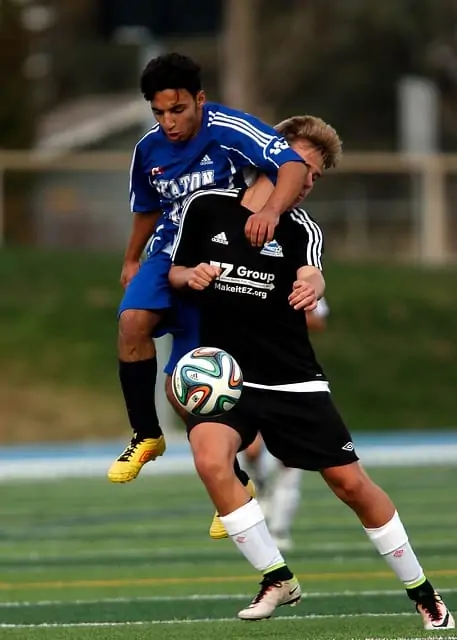
Encroachment in the Penalty Box
When players take a penalty kick, all other players must be outside the box (including the arch on the box).
Players who enter the box or arc and clearly impact the kick’s outcome are encroaching.
According to the Premier League,
“for player encroachment in the box, it is now judged on any part of a player’s body that is on the ground when the kick is taken.”
English Premier League Association
Extra Time
Extra time is added to each half. The clock never stops during a half. If a player is injured or a substitution happens, the referee keeps track of the time it took. At the end of the half, that time is added on.
If a ref adds 3 minutes of extra time, the fourth referee will show a sign with “3” when the normal half-time ends.
While extra time is one of the rules of soccer, it is rarely given in youth games. College soccer games also do not use the extra time. They will stop the clock.
Goal Kick
The team defending is awarded a goal kick with the opposing team plays the ball out of bounds over their end line.
If Team A is defending and Team B plays the ball out of bounds over Team A’s defensive end line, then Team A gets a goal kick.
For a goal kick, the ball is placed anywhere within the 6-yard box, including on the line of the 6-yard box.
- The ball does not have to be placed on the side the ball went out of bounds on. Most often the goalkeeper takes the goal kick, but any player from the team can take the kick.
There has been a key change to goal kicks in the last couple of years. Previously, players could not receive the ball from a goal kick until it left the box.
This is no longer a rule. Now, players can receive a goal kick within their 18-yard box.
Goalie Picks Up the Ball
The goalkeeper can pick up the ball in the run of play, but only in their 18-yard-box. Once the goalkeeper picks up the ball, they have six seconds to put it back into play.
If the goalkeeper does not release the ball after six seconds, they receive a warning from the referee and a yellow card.
Goalie Obstruction
When a player blocks the goalkeeper from getting the ball without making a play on the ball himself, he is obstructing the goalkeeper.
Goalie Interference
Goalkeeper interference is when an opposing player stands deliberately in front of the goalkeeper to block them from playing the ball.
If the goalkeeper has hand control (possession) of the ball, an opponent cannot interfere with or challenge the ball.
Goalie Uses Hands Outside the Box
The goalkeeper can only use their hands in their 18-yard box.
If the goalkeeper handles the ball outside of the box, they will receive a yellow card (red card if they stopped a clear goal-scoring chance).
Handling
One of the most well-known rules in soccer is that you cannot use your hands/arms. However, “handball” is not a rule.
The ball simply making contact with a player’s hand or arm is not a call; rather, the play must handle the ball.
Handling is always called if a player intentionally touches the ball with their hand/arm.
- Even if not intentional, it is handling if the player gains possession or ball control after touching it with their hand or arm.
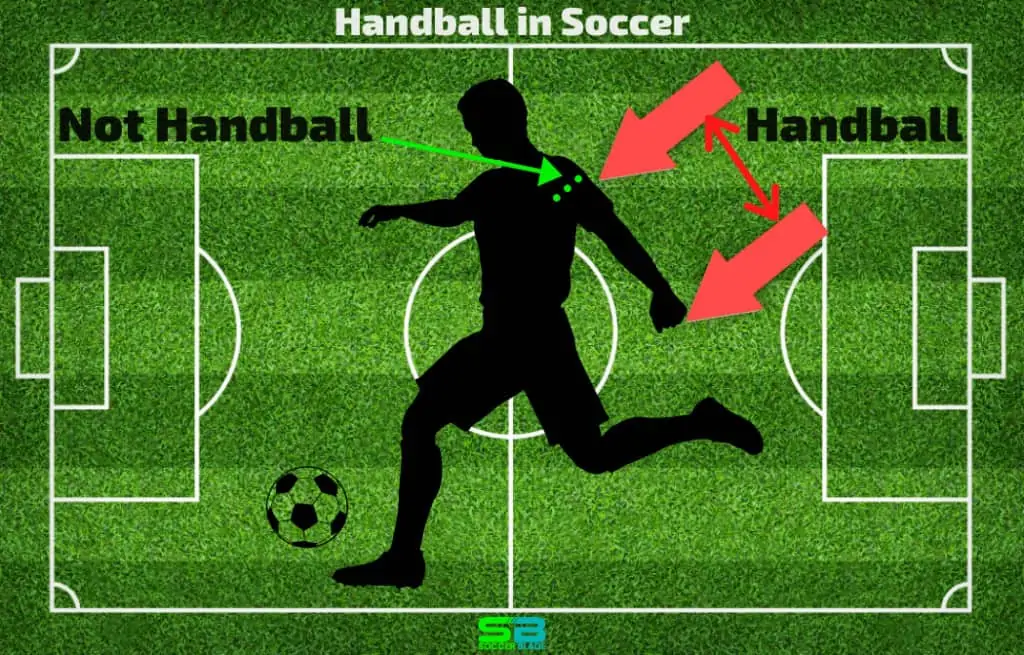
Even if accidental, if a player scores a goal directly from their hand or arm, it is not a goal, and handling should be called.
Hand handling is usually called if the player has made their body bigger using their hands and arm, or if the hand/arm is above shoulder level when contact is made.
However, it is not handling when:
- The ball touches the hand or arm when it is close to the body.
- The ball his a player’s hand/arm directly from their body part or a body part of another player is close.
- When a player is falling and the hand/arm is between the body and ground to support the body (as long as it is not extended laterally or vertically).
Handling the Ball in the Box
Handling can occur anywhere on the field. If a defensive player handles the ball in their defensive box, then a penalty kick is awarded to the other team.
The defending team earns a direct free kick if an attacking player handles the ball in their attacking box.
High Kick
If a player swings his leg above waist height near another player, they may be called for a high kick.
Often, the high kick results in an indirect free kick for the opposing team.
Heading back to Goalie
Heading the ball back to the goalkeeper is an exception to the “back pass to the goalie” rule. Imagine the goalkeeper is on Team B.
If a defender from Team B intentionally heads the ball to their Team B goalie, the goalie can legally pick up/handle the ball.
Indirect Free Kick
An indirect free kick is awarded for several different types of fouls. This type of free-kick requires another player to touch the ball before it can enter the goal.
Therefore, you cannot score “directly” from an indirect free-kick. Another player on either team must touch the ball first.
Here are infractions that can lead to an indirect free kick:
- Dangerous play, like a high kick.
- Obstructing the opponent, if a player blocks another player’s movement even when they are not in playing distance of the ball.
- Impeding the goalkeeper.
- Unsporting behavior.
- Dissent.
Kick-Off
Each half begins with a kick-off. A coin toss decides the first kick-off, and the opposite team will kick-off the second half.
The ball is placed on the center dot of the center circle on the field.
The team taking the kick-off can be in the center circle, but the team defending the kick-off can not under until the ball has been touched.
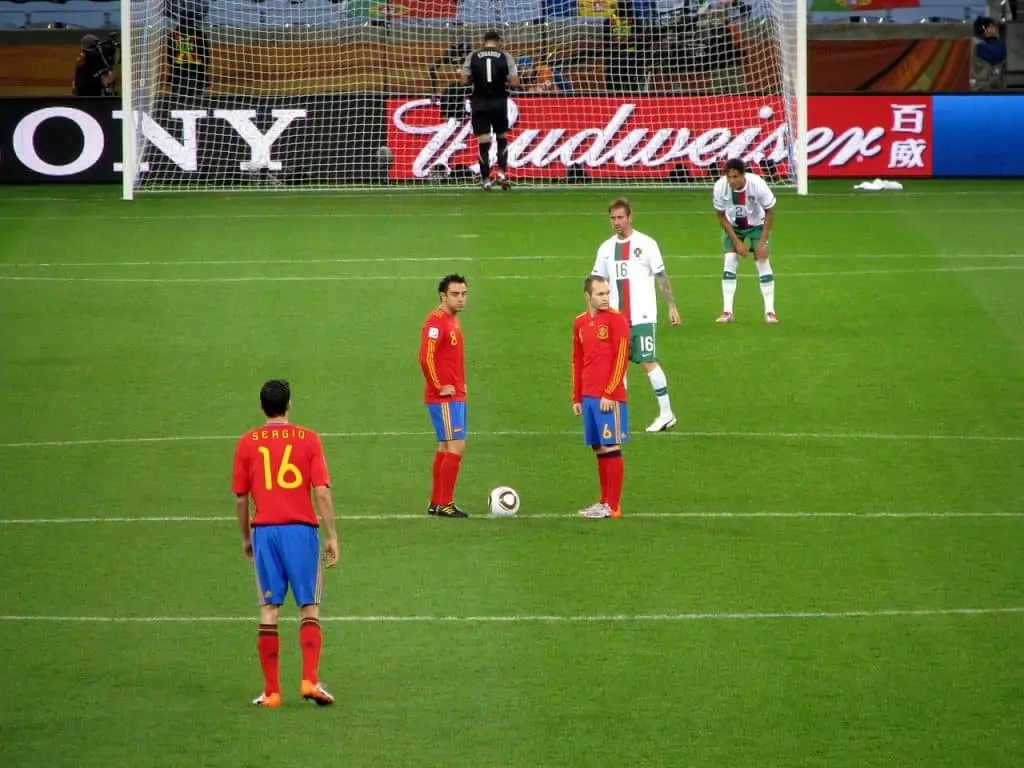
Some rules regarding the kick-off include:
- All players must be in their half of play.
- The player who takes the kickoff cannot touch the ball twice in a row.
- The referee must signal the start of the kick-off.
- You can score directly from a kick-off
Kick-Off After a Goal
Following a goal, the team who was scored on will take a kick-off. The rules regarding a kick-off remain the same (players must be on their half, etc).
Kit Rules
FIFA rules require players to wear a jersey, socks, and shorts. Any undershirt or tight must be the same color as the uniform.
Teams need a light-colored kit and a color-toned kit. Goalkeepers must wear a kit that is distinguishable from all field players on both teams.
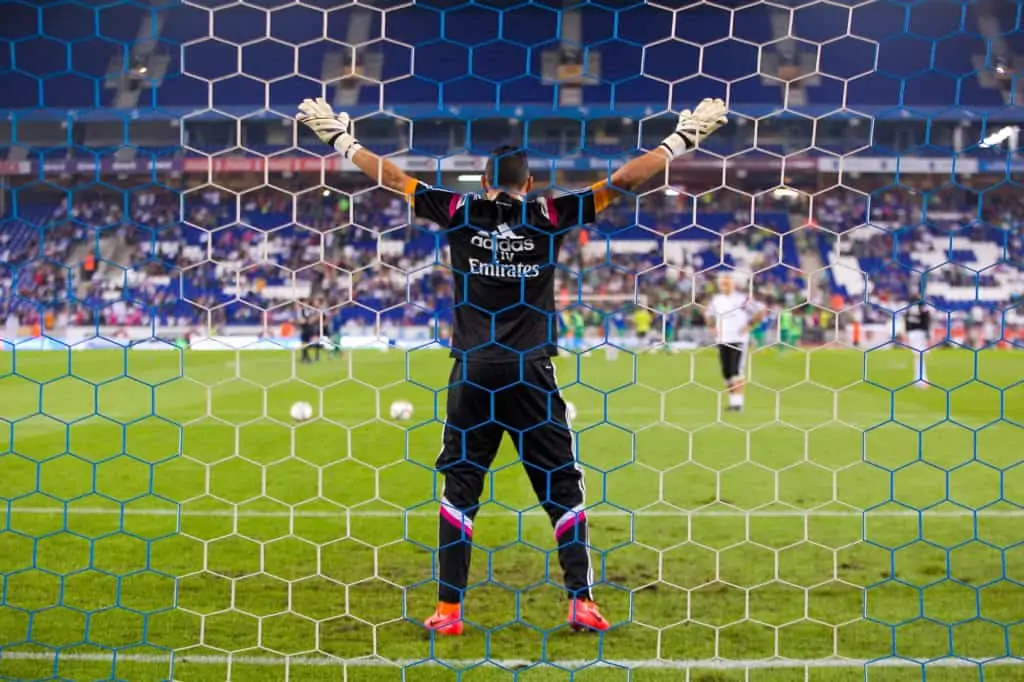
Jerseys must have readable numbers on the back that are pressed or sewn in, and each player on a team must have a unique number.
Additionally, jerseys cannot have more than four colors.
Last Defender Foul
The “last defender foul” often refers to denying a clear “goal scoring opportunity.”
FIFA rules do not specifically mention the “last man back”, but instead, the referee must determine if the foul thwarted a goalscoring opportunity.
Man-Marking/Player-Marking
Man-marking or player/marking is a traditional way of saying each player has one opposition player to mark.
You keep between your goal and the opposition player to mark another player. Make sure they don’t get past you and stay within a yard.
This is typical when you’re a defender or midfielder and especially important for corner kicks. The other type of marking is zonal marking, which we’ll look at later.
As in the example below, each player will not always have an opposition player to mark. So they will stay in their zone.
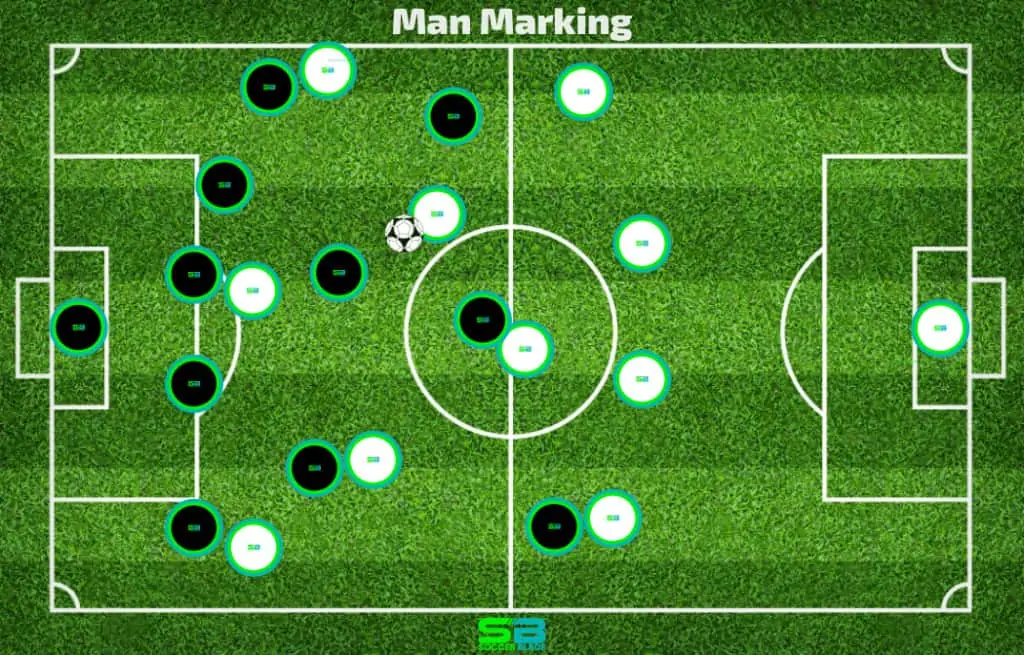
Number Rules
The numbers on uniforms must be distinguishable. They have to be a different color than the jersey and must be sewn or pressed onto the jersey.
- Players can wear any number given to them from the team roster. The range is normally 1 to 39, but there have been players that have worn number 99.
The higher the number, the lower the rank of the player. The youth and reserve players have the higher numbers.
There are occasions when players keep their number even when they are star players because they keep it as their lucky number.
Nationality Rules
Nationality determines which international teams a player is eligible for.
The definition of nationality for soccer is
“any person holding a permanent nationality that is not dependent on residence in a certain country is eligible to play for the representative teams of the association of that country.”
Goal.com
Players with more than one nationality could change national team alliance only once, even if the player played at the senior level.
Offside
If a player is on their attacking half and behind the defending team’s last defender when the ball is played, the player is offside. An offside call results in an indirect free kick.
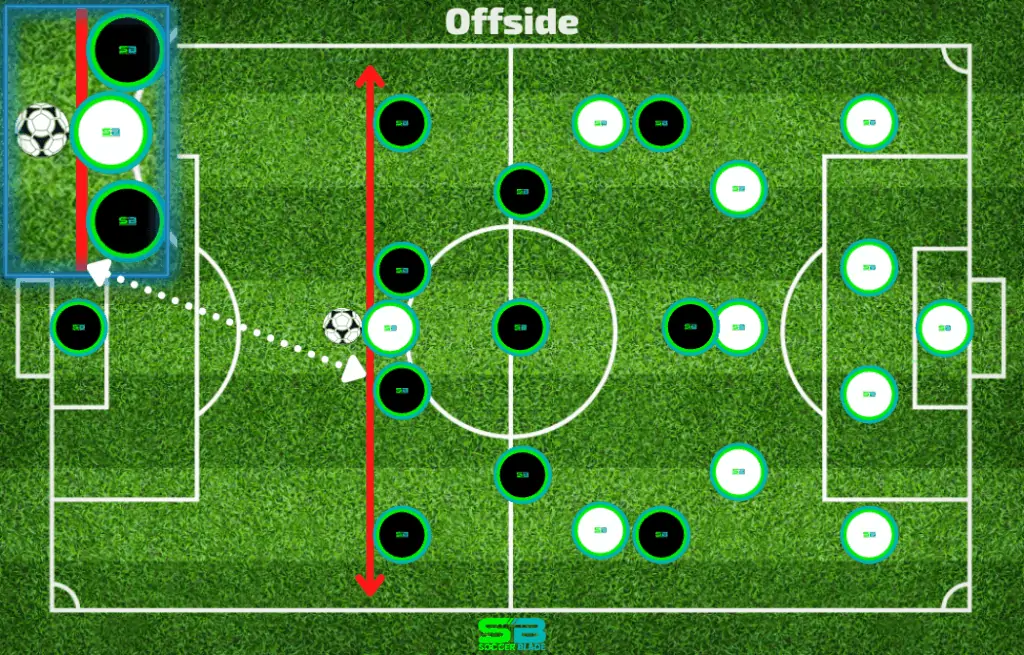
The Assistant Referee must stay in line with the defending team’s furthest back defender to monitor the offside line. Timing is crucial.
- Should the attacking player run behind the defender after the ball is played, they are onside, not offside.
Additionally, if the defensive player makes an intentional play for the ball, the player in the offside position will not be Beforecalled offside.
Furthermore, players cannot be offside on a throw-in.
Out of Bounds
A ball that has crossed the field’s boundary lines is out of bounds. The whole of the ball must be over the line for it to be out of bounds.
An out-of-bounds ball results in a throw-in, corner kick, or goal kick for the team that did not put the ball out of bounds.
Obstruction
Obstruction is “impeding the progress of an opponent” when not in playing distance of the ball. Obstruction is punishable with an indirect free kick.
Pushing
Legal contact is permitted in soccer, but pushing with the arms is not.
Pushing is banned by FIFA as well as the NCAA. shoulder-to-shoulder contact with reasonable force will not be called for pushing.
- Extending the arms from the body to shove is pushing.
Penalty Kick
You are fouling an opponent in your defensive 18-yard box results in a penalty kick for the opponent. The ball is placed on the dot 12 yards from the goal for a penalty kick.
The only players in the box are the goalkeeper and the opposing goalkeeper.
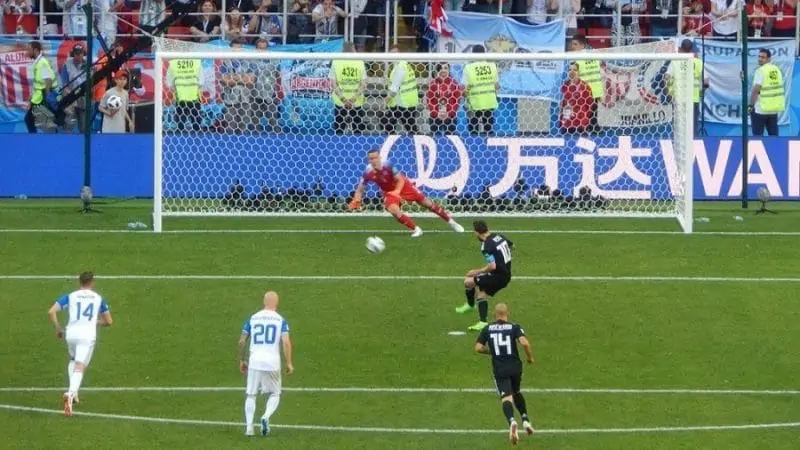
The shooter can approach the ball and shoot the penalty kick when the referee blows his whistle.
- The shooter cannot take more than one touch. The goalkeeper can move laterally leading up to the shot, but he can not step forward off the line.
A penalty kick scored during a game and counts as a goal.
If the goalkeeper blocks the kick or the kicker misses, play continues as normal after the penalty kick.
Physical Contact
Physical contact is part of the game of soccer. Legal forms of physical contact include:
- Shoulder-to-shoulder duels
- Shielding the ball.
- Contact during 50/50 plays
However, not all physical contact is allowed. Examples of physical contact that will result in fouls include:
- Pushing
- Shoving
- Kicking the player
- Punching
- Excessive force
- Grabbing
Red Card
A red card is the most serious consequence of misconduct. Players can earn a direct red card or two yellow cards that equal a red.
A red card sends the player off of the field. The player cannot re-enter and will also have to sit out the next game.
The player’s team will not be able to substitute another player, so they must play down a player for the rest of the game.
Infractions that result in a red card include:
- Extreme foul play (as determined by the referee)
- Spitting at someone
- Abusive language
- Violence (striking another player or referee)
- Intentionally fouling on an attacker with a clear goal-scoring opportunity
Referee
The referee enforces the rules of the game. There is a center referee and an assistant referee on each side of the field.
At the professional level, there is also a fourth referee who manages substitutions.
- The center ref has the final say for any calls, and the assistant referees primarily focus on calling offside and notifying the center ref of any fouls nearby.
The referees wear a uniform different than the uniform of both teams. They are all dressed in the same uniform.
The center ref has a whistle that he uses to stop the play. The assistant referees each hold a flag that they raise to alert the center ref of an offside or foul.
Restart
A restart is used to continue the play once it has stopped. There are different types of restarts based on the reason the play stopped.
The primary types of restarts are:
- Throw-ins
- Goal kick
- Corner kick
- Kick-off
- Dropped ball
Scoring
There is only one way to score in soccer: to put the ball over the goal line between the goalposts of the opponent’s net. A team earns one point per goal in soccer.
Substitutions
Substitutions occur when a team switches a player from the bench to a player on the field.
The number and timing of substitutions allowed depend on the level of play.
Before COVID-19, teams were allowed three substitutions during a game. Many leagues during COVID-19 allowed for five substitutions.
When players substitute, they can not re-enter the game even if they came out for an injury (this is different for youth and college soccer).
Throw-In
When the ball goes out of bounds over the sideline, the team who did not play it out gets a throw-in.
The throw-in must be taken from behind the line. The ball must come straight back behind the player’s head with both hands during the throw-in.
- Both feet must be on the ground during the throw. Players cannot be offside on a throw-in, but a team cannot score directly from a throw-in.
An incorrect throw-in results in a throw-in for the other team (at higher levels).
Yellow Card
A yellow card is an official warning from the ref about player conduct. Yellow-card offenses include:
- Delaying a restart
- Refusing to respect the required distance on a free-kick
- Persistent offenses of the laws of the game
- Unsporting behavior
Zonal Marking
Marking is when you stand near an opposition player in close range to stop danger from occurring. Zonal marking is when you stand in an area near an opposition player.
You will often see zonal marking when a team defends a corner kick.
Instead of each player marking one player each (man-marking), each player will have a zone to defend – a 2-yard square.
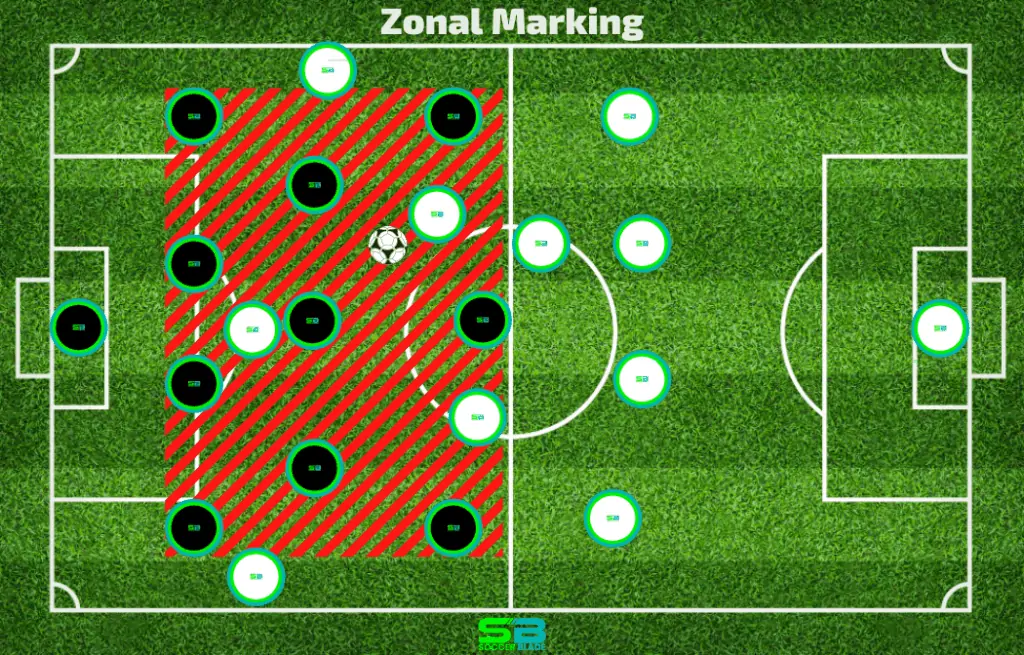
That completes the 48 A-Z rules in soccer which come from the official laws of the game – you can see the official 17 laws of the game in this article.
Share the post "48 Important Soccer Rules (A-Z Explained)"
Joel is a seasoned soccer journalist and analyst with many years of experience in the field. Joel specializes in game analysis, player profiles, transfer news, and has a keen eye for the tactical nuances of the game. He played at various levels in the game and coached teams - he is happy to share his insight with you.



